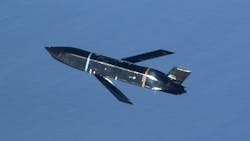Lockheed Martin to build six more LRASM anti-ship missiles with GPS/INS, infrared, and radar-homing sensors
EGLIN AIR FORCE BASE, Fla. – U.S. Air Force airborne weapons experts are asking Lockheed Martin Corp. to build six next-generation AGM-158C Long-Range Anti-Ship Missiles (LRASM) for use against high-priority enemy targets like aircraft carriers, troop transport ships, and guided-missile cruisers.
Officials of the U.S. Air Force Life Cycle Management Center at Eglin Air Force Base, Fla., announced a $17.6 million order Friday to the Lockheed Martin Corp. Missiles and Fire Control segment in Orlando, Fla., to build six LRASMs.
The LRASM can be guided toward enemy ships from as far away as 200 nautical miles by its launch aircraft. The missile employs a multi-mode sensor suite, weapon data link, and enhanced digital anti-jam Global Positioning System (GPS) to detect and destroy important targets within groups of ships at sea.
The missile can receive updates via its datalink, or can use onboard sensors to find its target. LRASM will fly towards its target at medium altitude then drop to low altitude for a sea skimming approach to counter shipboard anti-missile defenses.
Related: Lockheed Martin to double production rate of JAGM missile
The LRASM uses on-board targeting systems to acquire the target independently without the presence of intelligence or supporting services like GPS satellite navigation and data links. Lockheed Martin is designing he missile with advanced counter-countermeasures to evade hostile active defense systems.
Lockheed Martin is in charge of LRASM overall development, and the BAE Systems Electronic Systems segment in Nashua, N.H., is developing the LRASM onboard sensor systems.
The BAE Systems-designed seeker and guidance system integrates jam-resistant GPS and inertial navigation sensors (INS), an electro-optical imaging infrared seeker with automatic scene- and target-matching recognition, a data-link, passive electronic support measures (ESM) with passive radar homing, and radar warning receiver sensors.
Artificial intelligence (AI) software combines these features to locate enemy ships and avoid neutral shipping in crowded areas. The missile automatically disseminates target RF and infrared emissions data, and classifies, locates, and identifies these emissions for planning its path of attack.
Related: Sensor fusion missile seekers for LRASM anti-ship munition
LRASM's data-link enables other systems to feed the missile a real-time electronic picture of the battlefield to enable several of the missiles to work together by sharing data to coordinate an attack in a swarm.
Aside from short low-power data-link transmissions, the LRASM does not emit signals for low detectability. A LRASM also can find its own target autonomously by using its passive radar homing to locate sea and land targets.
LRASM is a joint project of the U.S. Defense Advanced Projects Agency (DARPA) in Arlington, Va., the Navy, and the Air Force to design an advanced anti-ship missile that can launch from the Navy F/A-18E/F Super Hornet jet fighter bomber, as well as from the Air Force B-1B Lancer long-range strategic bomber.
Related: Raytheon to build air-to-ground missiles, tri-mode seekers
In the future LRASM also will launch from the P-8A Poseidon maritime patrol aircraft, the F-35 Lighting II joint strike fighter, as well as from the Navy Mark 41 shipboard Vertical Launch System. Submarine-launched versions are under consideration.
The missile travels at high subsonic speeds that enable the missile to fly low near the surface of the ocean. This enables the missile to hide in the curvature of the Earth from enemy air-defense radar for most of the missile's flight.
LRASM is designed to detect and destroy high-priority targets within groups of ships from extended ranges in electronic warfare jamming environments. It is a precision-guided, anti-ship standoff missile based on the Lockheed Martin Joint Air-to-Surface Standoff Missile-Extended Range (JASSM-ER).
Related: Lockheed Martin to build air-to-surface missiles
The Lockheed Martin LRASM has a 1,000-pound penetrator and blast-fragmentation warhead, multi-mode sensor, weapon data link, and enhanced digital anti-jam global positioning system to detect and destroy selected surface targets within groups of ships.
LRASM development is in response to a gap in Navy anti-ship missile technology identified in 2008. The standard Navy anti-ship missile is the subsonic Harpoon, which has been in the inventory since 1977.
On this contract Lockheed Martin will do its work in Orlando, Fla., and Troy, Ala., and should be finished by March 2025. For more information contact Lockheed Martin Missiles and Fire Control online at www.lockheedmartin.com, or the Air Force Life Cycle Management Center at www.aflcmc.af.mil.

John Keller | Editor-in-Chief
John Keller is the Editor-in-Chief, Military & Aerospace Electronics Magazine--provides extensive coverage and analysis of enabling electronics and optoelectronic technologies in military, space and commercial aviation applications. John has been a member of the Military & Aerospace Electronics staff since 1989 and chief editor since 1995.

